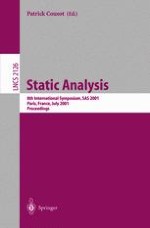2001 | Buch
Static Analysis
8th International Symposium, SAS 2001 Paris, France, July 16–18, 2001 Proceedings
herausgegeben von: Patrick Cousot
Verlag: Springer Berlin Heidelberg
Buchreihe : Lecture Notes in Computer Science
Enthalten in: Professional Book Archive
